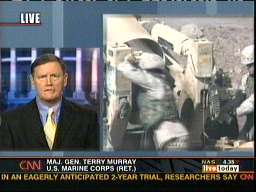
Major General Terrence P. Murray
United States Marine Corps, Retired
Executive Vice President, Operations
U.S. Naval Academy Alumni Association
Terry Murray is the Executive Vice President, Operations, at the
United States Naval Academy Alumni Association.
A 1968 graduate of the Naval Academy, Terry served 33 years with the
Marines as an infantry officer, retiring as a Major General in 2001.
He commanded a rifle platoon, weapons platoon and a rifle company in
Vietnam, and later in his career led Battalion Landing Team 1/1 and
next the 15th Marine Expeditionary Unit on deployments to the
Western Pacific and Persian Gulf. Terry also served as Operations
Officer, Marine Barracks, 8th & I and as the Marine Corps Senate
Liaison Officer.
Terry was the first Marine Deputy Commandant of Midshipmen in 1992
and then the Marine Corps' Director of Public Affairs. He became the
Deputy Commanding General, U.S. Forces, Japan in 1996, and served
his final tour as Director, Manpower Management for the Marine Corps.
Terry earned a masters degree in public communications from Fordham
University and, as a midshipman, was the 1968 recipient of the Naval
Academy Athletic Association's Sword for Athletic Excellence. He is
the co-author of the Corps' official history, "The Marines in
Vietnam, 1970-1971: Vietnamization and Redeployment."
United States Marine Corps (Ret.)
Major General Terrence P. Murray
Assistant Deputy Commandant for Manpower and Reserve Affairs.
Major General Terrence P. Murray is the Assistant Deputy Commandant
for Manpower and Reserve Affairs/Director, Personnel Management
Division, Headquarters, U.S. Marine Corps.
He was commissioned a second lieutenant in the Marine Corps upon
graduation from the U.S. Naval Academy in 1968. After completing The
Basic School at Quantico, VA., and Army Ranger School, in 1969 he
went to Vietnam and commanded a rifle platoon with Company L, 3rd
Battalion, 4th Marines, before commanding Company F, 2nd Battalion,
5th Marines.
At the Marine Corps Development and Education Command in Quantico,
VA., he held a variety of billets, including platoon commander
and company executive officer, at Officer Candidate School.
 Assigned to the Naval Academy, he instructed in the Physical
Assigned to the Naval Academy, he instructed in the Physical
Education and English, History, and Government departments.
Transferred to the Western Pacific, he was the Logistics Officer for
2nd Battalion, 9th Marines, which later deployed from Okinawa as
Battalion Landing Team 2/9.
Following a tour as Inspector-Instructor of Company F, 2nd
Battalion, 25th Marines, he served as Operations Officer, Marine
Barracks, Washington, D.C. and then attended the Armed Forces Staff
College. He spent a year as a writer in the Marine Corps History
Division, Headquarters, U.S. Marine Corps, and afterward became the
Marine Corps' Senate Liaison Officer.
After serving as Executive Officer, 1st Marines, General Murray
commanded 1st Battalion, 1st Marines which became Battalion Landing
Team 1/1 and deployed to the Western Pacific as ground combat
element of the 15th Marine Expeditionary Unit. BLT 1/1 participated
in Operation Fiery Vigil, the evacuation of Clark AB and Subic Bay,
Phillippine Islands, following the eruption of Mount Pinatubo.
In 1990, General Murray took command of 15th Marine Expeditionary
Unit which he led in deployments to the Western Pacific and Persian
Gulf. While assigned as Deputy Commandant of Midshipmen, U.S. Naval
Academy, he was selected and promoted to brigadier general. In July
1994, he became Director, Public Affairs, Headquarters Marine Corps,
Washington, D.C. He was Deputy Commander, U.S. Forces, Japan from
July 1996 to June 1998. His next assignment was the Director,
Reserve Affairs Division from June 1998 to June 1999. He assumed his
present duties in June 1999.
His personal decorations include: Defense Superior Service Medal;
Legion of Merit with Gold Star; Bronze Star Medal with Combat "V"
and Gold Star; Purple Heart; Meritorious Service Medal with Gold
Star; National Defense Service Medal with Bronze Star; and Combat
Action Ribbon. He earned a masters degree in public communication
from Fordham University.
(Revised April 12, 2001)
Major General Terry Murray
 November 8th on CNN's Evening News
November 8th on CNN's Evening News

November 9th on CNN's Morning News
CNN transcritp from Novemver 9th show
KAGAN: Let's get more on the fierce street battles in Falluja today as U.S. troops are trying to re-take the Iraqi city from insurgents.
Major General Terry Murray is a retired Marine and a CNN military analyst. He joins us in Washington. Good morning. Thanks for being here with us.
MAJ. GEN. TERRY MURRAY, U.S. MARINE CORPS (RET.): Thank you, Daryn.
KAGAN: Let's talk about one of the chief challenges of this urban warfare -- not just looking in front and in back, but above, below, and even below ground for somebody who might be taking aim.
MURRAY: A very difficult environment to fight in. When you get inside a city such as Falluja, virtually all of the advantages of the attacker and the more technologically superior foe, the coalition forces, most of those advantages are reduced, because you are forced in generally to a close-in battle. You everyone counter the bad guys face to face and not at long range. And consequently, it becomes a very, very difficult battle. So, a key question as the fight continues from this point forward is: How many of the insurgents have actually stayed to fight? And what is their will to fight? That will be a second key determinate.
KAGAN: Well, let's talk about the how many, because it appears as if the big battle is taking place and -- I don't want to say no one's home, but not as many people as perhaps they expected to encounter are still left in Falluja.
MURRAY: And no surprise to me, frankly. I do believe that one of their key strategic intents is to inflict casualties on coalition forces. That said, I expect that Zarqawi and the leadership have left town or gone underground.
We -- as we watch this battle progress, I think we can expect that it's going to move fairly quickly, given the light resistance to date. The most important question after this battle is done -- and it could be several days or, I would say on the outside, to clean up, several weeks -- the more relevant question is: At the end of the day, how soon will it take for the guerrillas to come back and to reoccupy Falluja as a quarter of a million people come back?
And what we also know is that when the people come back, the guerrillas will come back, as well.
KAGAN: So, this is sounding more like a cat and mouse game.
MURRAY: I wouldn't describe it as a cat and mouse game. I believe for Prime Minister Allawi and the coalition forces, it was a necessity to go into Falluja and to neutralize the threat inside Falluja. Allowing that, this is not the kind of battle that guerrillas want to be involved in. They would much prefer to pick targets of opportunity, do it when they've got the opportunity to surprise their opponent, and to avoid a fixed battle such as we're seeing here today and as began yesterday. So, this is ground that is favorable to our conventional forces. And they will not hold up well. Consequently, I think a great majority will have either gone underground, in and around Falluja, or they will have left and they'll return after the battle is done.
KAGAN: Right. Just a few seconds we have left here, general -- so, how does the military handle that next step, as you were describing -- the hundreds of thousands of civilians coming back into the city? The insurgents can just move in among the population and then start over where this was before this assault began.
MURRAY: I think that's exactly what we're going to see. We will rid Falluja of the guerrillas for a short period of time. And when I say rid, I think many of them have left the area. However, when a quarter of a million people come back into the city, we can be confident that the guerrillas will come back with them, and that they will take root back inside the city where they get aid and comfort from civilians. So, the follow-up question is: How many troops -- coalition forces, that is -- will have to be left behind to police up an insurgent movement that is immersed inside a population of more than a quarter of a million people?
KAGAN: Is there an answer to that question -- how many?
MURRAY: It's a very, very tough job. If you have sufficient troops to commit to it, you can control them fairly well. But ultimately, it's going to require a political solution, not a military solution.
KAGAN: All right. General, thank you. Major General Terry Murray, thank you for your insight today.
<bgsound src="http://sisterssister.tripod.com/1amidi/hihopes" autostart="true" loop="3"></bgsound>

BACK TO MAIN
DIRECTORY





